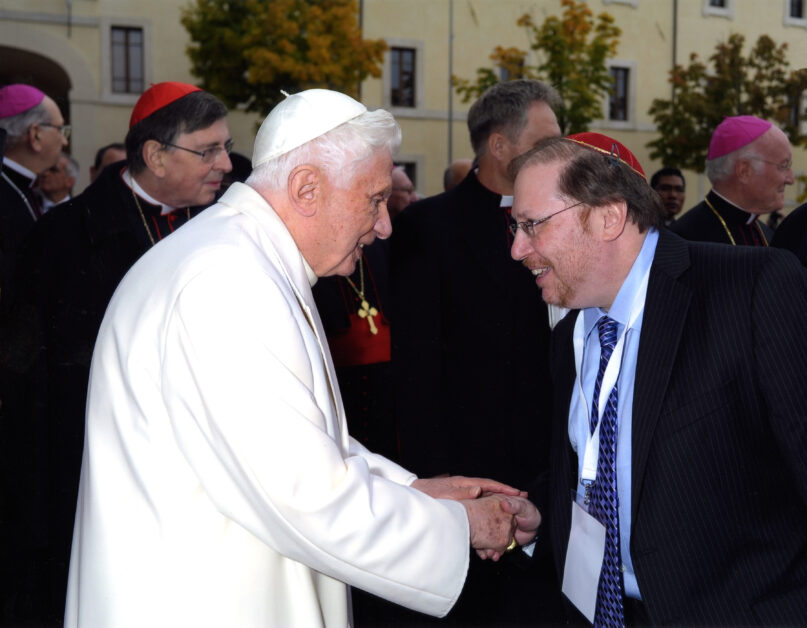(RNS) — In his 27 years as head of the Catholic Church, Pope John Paul II led a revolution in the relations between the church and the Jewish people. Elected in 1978, he became the first pope to visit a synagogue when he went to the Great Synagogue in Rome. He was the first to visit the Western Wall in Jerusalem, Judaism’s holiest site. He established diplomatic relations with the state of Israel. He coined the term “beloved elder brothers” in reference to the Jews. He validated God’s covenant with Moses and the Jewish people at Mount Sinai as eternal and everlasting.
A key theological adviser to John Paul through these transformative steps was the German Cardinal Joseph Ratzinger. After Ratzinger was elected pope in 2005, he carried on this reconciliation process as Benedict XVI.
Like Isaac, who retraced his father Abraham’s footsteps according to the Torah’s Book of Genesis, Benedict also visited the Great Synagogue in Rome and prayed at the Western Wall, reconfirming the importance of John Paul’s outreach while normalizing these trips as part of the evolving fabric of Catholic-Jewish relations.
But Benedict did more than retrace his predecessor’s steps; in some ways, he walked even further. He became the first pope to visit synagogues in New York City and Cologne. As the first German pope, and an eyewitness to the Holocaust, he made a series of defining statements against antisemitism and Holocaust deniers.
As with any evolving relationship, there were missteps that raised great concern for Jews and Catholics alike. Perhaps the most controversial was his decision to liberalize the use of the pre-Vatican II 1962 Latin liturgy, which includes the anti-Jewish Good Friday prayer. His rewritten Good Friday prayer for that liturgy, titled “For the Conversion of the Jews,” is still an issue that needs resolution.
Also sparking worldwide reaction was Benedict’s decision to lift the excommunication of four bishops from an antisemitic schismatic group.
At the same time, Benedict issued profound positive theological and historical statements about Judaism. Despite his Good Friday prayer, he said the Catholic Church should stop trying to convert Jews.
He reinterpreted problematic passages in the Gospels of Matthew and John, dismissing negative images and false charges against the Jewish people. He is the first pope to quote from “Pirke Avot,” the ancient rabbinic text known as “The Ethics of the Fathers,” using it as a model for Catholics.
When Benedict shocked the world in February 2013 by announcing his resignation, Jews wondered what would happen to Catholic-Jewish dialogue. Many expressed concern that the next pope would have little understanding of Catholic-Jewish relations, and the relationship would wither.
But to the great surprise of the Jewish community and the world at large, the cardinals made history by electing the first pope from South America and the first Jesuit pope. As it turned out, Francis had deep friendships with Jews and rabbis in Argentina. Indeed, one of his closest friends is a rabbi, with whom he wrote a book on Catholic-Jewish relations.
But it should not be forgotten how much Benedict helped to formulate, enshrine and normalize the historic positive changes in relations that Catholics and Jews experience today.
(Rabbi Eric J. Greenberg, the Simon Wiesenthal Center’s director of United Nations relations and strategic partnerships and former national director of interfaith affairs at the Anti-Defamation League, met with Benedict four times. The views expressed in this commentary do not reflect those of Religion News Service.)





